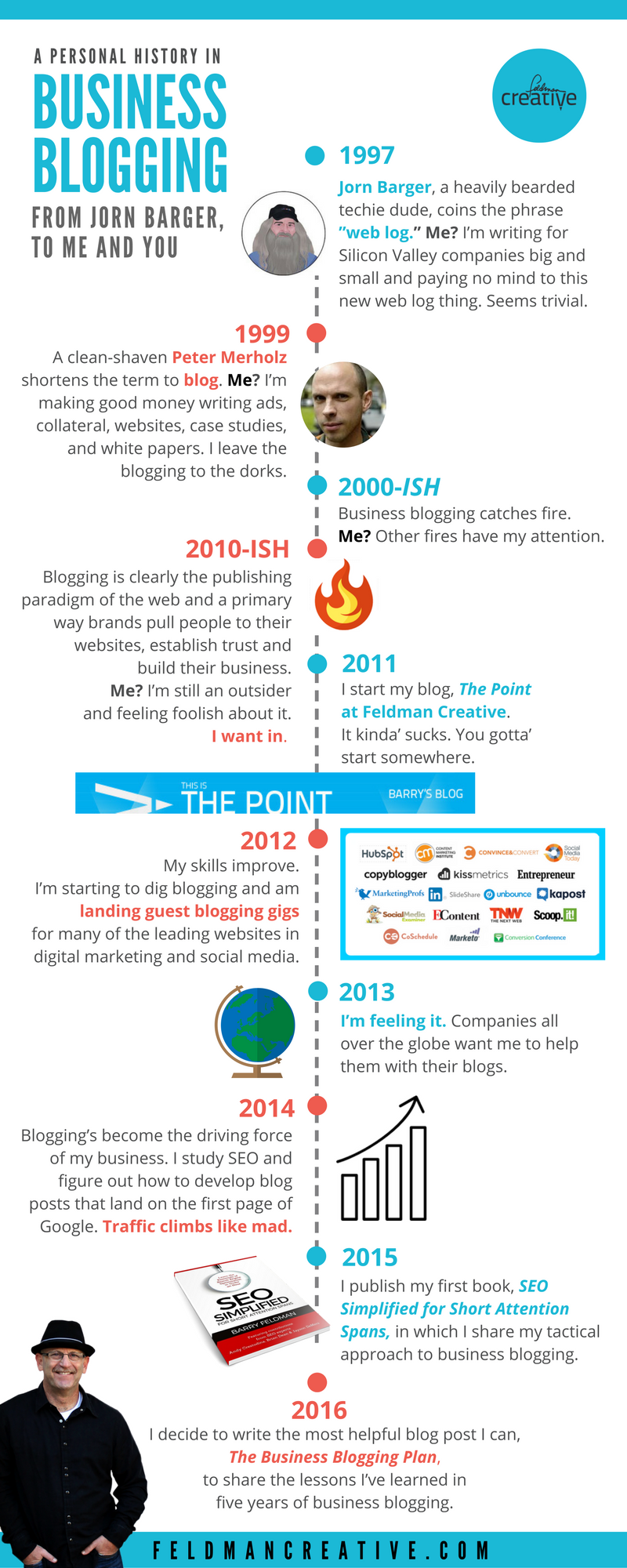I must admit: I’m a latecomer to business blogging. I joined the party in 2011 and got off to a rocky start. Nearly all bloggers do.
Five years later, I know what works. I’m working the strategies to great effect—on my website, for a long list of top marketing blogs, and for many clients. And regardless of where you are in your business blogging journey, I believe this collection of ideas will help you publish an even more effective business blog.
Here, now, are my top ideas organized as 50 best practices. But first…
I present a quick history of business blogging from the historical point of view of yours truly. And then… Grabba’ cuppa’ something tasty and enjoy The Business Blogging Plan.

Here you go…
The Business Blogging Plan: 50 Best Practices

Targeting: Start with why, who, what and where
As a business blogger, you become an online publisher. Your starting point is to document a concise plan to address the fundamental why, who, what and where questions.
1. Why will you have a business blog? Most business bloggers aim to establish expertise in their niche and generate interest in products and services to support the growth of their company. Business blog objectives are likely to include:
- Raise brand awareness
- Increase web traffic
- Start conversions
- Establish trust
- Develop authority
Establish your goals by using any or all of the above in your plan or edit the list to address your specific objectives.
2. Who’s the blog for? Create a persona (or multiple personas) to describe a prototype reader. Include both demographic and psychographic details. The goal is to develop a clear understanding of what pushes the reader’s buttons, intellectually and emotionally.
3. What will the blog offer? How will your content satisfy the needs of its readers? My blog aims to deliver actionable digital marketing advice to help readers get traffic, leads and sales. Note the statement I just wrote answers what the blog offers AND its value.
4. Where will it be published? Business blogs should not be published offsite, that is, on platforms such as Blogger.com, WordPress.com, Tumblr, Medium, LinkedIn, etc. You may want to take advantage of these channels that make publishing a cinch—in addition to your blog—however, your interests are best served by hosting your main blog on your domain.
- Your blog can simply be your website:
CompanyName.com - Or your blog can be a sub-domain or sub-directory:
CompanyName.com (blog.FeldmanCreative.com), or
CompanyName.com/blog (FeldmanCreative.com), or
CompanyName.com/NameOfBlog (FeldmanCreative.com/ThePoint)
After considering each issue above, document a mission statement to define, in a sentence or two, what you will publish, for whom, and the specific value of the content.

Topics: Create an editorial plan
Your business blog needs to focus on specific topics, but be broad enough to allow you to perpetually create new and useful content. Let’s get into some practical approaches for identifying topics and extracting ways to use them to publish relevant content regularly.
5. ID the questions prospects ask—You need to discover your prospects’ interests, concerns and challenges and interpret them as questions. What would they enter in search?
Your prospect’s questions come at you (or someone in the company) all day, everyday, and in all kinds of ways: chat, email, phone calls, blog commentary, etc. As a business blogger, you need to tune-in closely and document the questions. Gather them from people in customer-facing departments across the company.
Also, spend time on the social media channels your prospects use. Look for questions and conversations about business challenges. Make and maintain a list of them. You’re going to answer them on your blog.
6. Swipe ideas—On an ongoing basis, you should read the content published in your niche: in blogs, social media and books. When you discover something promising, swipe the idea and document it. Of course, you don’t want to plagiarize headlines or copy, but you want great ideas to inspire yours. Create a “swipe file” of inspiring ideas.
7. Monitor your market—Stay plugged into what’s going on in your field. You can keep tabs on industry news with alerts, feeds and media monitoring tools. Stay on top of breaking news, new solutions, activities of your competitors, and anything published about your company.
8. Extend ideas—Don’t let a big idea be a singular idea. Use mind mapping apps, a whiteboard, flipchart, sticky notes or whatever you prefer to brainstorm subtopics and ideas that relate to the core idea and build a bigger story.
Over time, the response you get will help you understand the type of editorial content your readers like. Look for ways to extend the winners by updating posts (rewrite, add ideas, add video, etc.), expanding them, giving them new twists, and finding additional media outlets for them.
9. Ask your readers—Ask your readers how you can publish content that will help them succeed. You can do this via email invitations to surveys, with on-site survey tools, through groups and forums, and yes, in conversation.
10. Log your ideas—When you start blogging regularly, creative ideas will come at you constantly. You can’t get to them all, not immediately. Archive them. Whether it’s with a notepad, computer, cloud app or recorder, summarize the idea to the point where it will make good sense when you return to it.

Presentation: Make your blog inviting
Cluttered pages repel readers. The inverse is true too. Tidy, good-looking blogs make the user experience a pleasure, increase time-on-site and help you gain loyal subscribers.
You have options here, but ignoring graphic design isn’t one of them. You can purchase a professionally designed template, hire a web designer, or learn the ropes. Make it a priority to make your blog look great.
11. White space—Compare a page densely populated with copy to another with a more “air,” that is, ample white space, and you’ll choose the latter every time. Pay attention to margins, breaks, and leading (the space between the lines of copy) to ensure your page is generously white (or a light and pleasing background color).
12. Create and use images—Blogs with no images look dull and monotonous. Add visual interest to your posts with:
- Photos
- Word clouds
- Diagrams
- Illustrations
- Infographics
- Screen shots
- Quotes
- Video
Of course, you can buy images and/or use non-copyrighted works, but it’s best to create something original. Avoid corny stock photos.
13. Bullet points—Readers love lists. Use bullets or numbers to set apart sequential ideas, even if you have just two or three. The more you enable speed-reading, the more visitors will want to read.
14. Subheads—Break up your blog posts by “chapterizing” them with subheads. Subheads help make your page look cleaner and your post more skimmer-friendly. And search engines may recognize them (so choose your words wisely).

Blog post ideas: Publish an interesting mix
Many blogs are one-trick ponies. For instance, every post is a deep, 1,000-plus- tutorial on a narrow niche. You run the risk of boring readers with this type of predictability.
I believe a great blog delivers variety. This section offers ideas to vary the content of your blog to make it interesting to more people.
15. List posts—It may be an unsurprising first tip, but I want you to succeed. List posts work. Create them often.
16. Resources posts—Another dependable staple of the business blogosphere is the resource post that aims to enlighten readers by listing high quality books, blogs, shows, products, services, apps, or just about any type of resource.
17. Roundup posts—A roundup is a resource post, of sorts, but instead of pointing readers to resources, you pull the resources into your story. A popular example is a post where an expert panel is asked the same question (often rounded up via email). You can grab material various ways from various sources.
18. Interviews—Interviews are great for variety and bring various points of view and personalities to your blog. You can conduct them from a variety of places with a variety of approaches. You can vary the form too by presenting written, audio and video interviews.
19. Reviews—Be a voice of authority and industry curator by reviewing books or any form of media. Review anything you deem relevant and potentially useful. Reviews of conferences are a good example.
20. Contrarians—Your blog should inspire readers. So yes, be positive. But if you vow to be eternally positive you could risk getting yawned to death. Take a contrarian stance now and then. Tackle myths, mistakes, misconceptions, and miscellaneous material to demonstrate you know wrong from right.
21. Stories—Storytelling takes practice. So start small. Open with a little anecdote, prediction, flashback, a conversation you heard, something you saw, a joke, whatever. Your stories will get richer, more personal, more you. Your blog will get more interesting—your readers, more interested.
22. Curate—Curation is presenting the works of others. It doesn’t mean your brain gets to go on vacation. If you want your readers to get a lot out of the content you curate, put some effort into it. You can tee-up favorite stories with an explanation of why you like them. Roll a collection of ideas together to support a story you want to tell. Present opposing views. Curation can be good fun for everyone.
23. Invite guests—Invite guest bloggers to contribute to your blog. Consider new authors. If you’ve made influential friends on your blogging journey, offer to trade guest posts. Or find someone with writing chops that would welcome the opportunity to find a new audience and could breathe new life into your blog.

Writing: Communicate with verve
Most business blogs suck. The writing simply has no heartbeat. It often feels forced and phony.
You need to bring passion to your blog. Does that mean you need to be a great writer to create a successful blog? Probably not. You need to aspire to become one.
Work at it and you will. Experiment. Gather feedback. You’ll learn what does and doesn’t work. Your writing skills will progress.
Identify a short list of blogs and bloggers that appeal to you and make a deliberate attempt at understanding why. Is it the writing style? The depth? Honesty? Humor? Wit? Sarcasm? The use of stories and examples? Data? Emulate stylistic ideas from some of your favorites. Your style will begin to emerge.
Here are some tips to put you on the path to becoming an effective writer.
24. Write several headlines— Lazy bloggers write a headline and then a post. Not good. The headline or title of your post is the most important line you’ll write. Put ample effort into making it great.
Don’t settle for your first idea. Challenge yourself to improve it. When your post comes together, revisit what you wrote and try writing five to ten alternative headlines. My bet is you’ll arrive at an even stronger one.
25. Identify with the reader in your lead—Most readers won’t get deep into or finish your posts. After your headline, your lead or opening is the most important passage.
It has to have sucking-in power. Communicate to the reader why your post is going to be meaningful to them. Arouse curiosity about what’s to come.
Writers tend to stare at their screens obsessing over the lead for too long. If this problem plagues you, skip the lead and start writing. Your first sentence or paragraph may become much easier after you get a first draft down.
26. Have a point of view—Don’t try to make everybody happy with everything you write. Write what you feel. Great bloggers share their opinions and present a strong point of view. That’s my opinion. I’m perfectly fine if you disagree.
27. Write naturally—I think (and we just established bloggers should freely express their opinions) nothing is more tedious than a blogger posturing as a journalist. Relax. Lighten up. Be yourself and write in your unique, real, natural voice.
28. Increase your word power—Powerful blog headlines and copy feature powerful words. I’m not talking about big words. I’m talking about words that trigger emotions. Review your drafts looking for opportunities to tighten your copy, inject active verbs, and dramatize your story.
29. Respect grammar— You need not obsess about grammar like you would with a report. Blog posts don’t need the approval of a professor. Understand what does and doesn’t abide by grammatical standards, but don’t be afraid to bend the rules in the interest of style. Just don’t embarrass yourself with careless grammar.
30. Give it rhythm—Short sentence. Short sentence. Boring, right? On the other hand, when you run on and on and on with ideas that could be broken up, you run the risk of making reading a chore. Strive to give your writing rhythm. Pacing’s important.
31. Cite research and data—Use the web as your library. Put some effort into enhancing the credibility of your posts with research and data that supports your story.
32. Proofread—Writing and editing all by your lonesome is a tough task. You’ll benefit from a second set of eyes. If an editor or proofreader is not an option, step up your own internal checking system. For spelling, try proofreading your posts backwards—yes, one sentence and word at a time. It also helps to incubate your posts, that is, let them lie for a day or more and return with fresh eyes. Far fewer mistakes will slip by.

Influence: Make connections to build your audience
You’ll achieve your business blogging objectives faster by building influence. To accelerate the process, savvy business bloggers create connections with the movers and shakers in their industry: the leading bloggers, authors and speakers. You’ll learn a lot, gain new opportunities and grow your audience.
33. Comment on blogs—Subscribe to and read the best blogs in your niche. Then join the conversation in the comment streams. You can do better than simply complementing the authors of posts you like. Write meaningful comments and you’re sure to get on the radar of influential bloggers.
34. Respond to comments—Big, multi-author blogs sometimes do away with comment streams. You shouldn’t. As an up-and-comer, you should encourage readers to contribute comments. Pay close attention to the comments. Respond to any questions you’re asked. Thank those that applaud your work and contribute thoughtful comments.
35. Create communities—Explore ways to communicate, exchange ideas, and create content with your fans, friends, and bloggers you admire. You can create a forum, join or start your own LinkedIn or Facebook group, host Twitter chats, and conduct webinars and meetups. Online and off, there are countless opportunities to commune with your audience and other bloggers.
36. Attend conferences—The top business bloggers are usually speakers too. They create content about what they’ve done, seen and learned at industry conferences.
You’ll need to carve time out of your schedule and dollars out of your bank account to get involved in conferences, but you’ll be rewarded for the investment. When you’re aiming to build influence by associating with leaders who author prominent blogs, nothing beats getting to know them.

Promotion: Invest heavily in increasing your reach
Millions of posts are published daily. Most reach very few readers and the majority doesn’t get shared via social media.
Serious business bloggers need to continuously amplify their reach by promoting their content. Let’s look at some key distribution strategies you’ll use to find an audience or help an audience find you.
37. Create social media updates—Content marketing and social media marketing are bedfellows. In fact, blogging, by most people’s definition, is social media. I’m forever shocked by business bloggers who hit “publish” and call it a day.
You must relentlessly promote your blog posts via the social media channels your potential customers frequent. Make your social media updates interesting, urgent, and creative. Feature images to increase their visibility and stopping power.
38. Try paid posts—Small investments in sponsored posts on social media channels are likely to have a big effect on your reach. Most popular networks now offer a variety of ad programs, which will allow you to apply a number of targeting options to zero-in on the audience you seek.
39. Send email updates—Get an email marketing program in place pronto. Use pop-ups, slide-ins and/or call-to-action boxes to make your readers aware you deliver updates via email and set your email service up to generate blog updates via email.
40. Build your email list—It’s crucial to build your email list. Put opt-in forms in the path of your website visitors on all popular pages and your posts. You might even create a page expressly for capturing new subscribers.
Creating gated offers is the best way to gather readers’ email addresses. Put some thought into it and create an eBook or another type of lead magnet that’s remarkably valuable.
41. Encourage sharing—Install a social media share bar. Though your share numbers may be low, I recommend turning the counters on. Deliberately ask your readers to share your posts. Consider using a “Click to Tweet” WordPress plugin to make it easy for readers to share pre-formatted tweets.
42. Get syndicated—While guest blogging is hard work, syndicating your blog posts is not. The work’s all front-loaded. Identify blogs that republish the works of bloggers in your niche and give the editor a good reason to consider running your stuff. They don’t pay you; you don’t pay them. But you both benefit.

Search: Optimize your blog posts for visibility
Does SEO sound scary? It’s really not the beast you fear. And it need not be slimy.
Google has chased away most of the schlocksters who gave SEO a bad name and now rewards great content creators who do the little things it takes to indicate to the search engine how the posts are relevant to readers’ requests.
43. Do keyword research—Though search has become increasingly semantic, keywords are still your key to getting discovered via search. Identify long tail keyword phrases (3 or more words) for which you have a chance to earn high rankings. Include them in your headlines. Include derivatives of them in your copy. Tag your images with your keywords too.
44. Tighten your URLs—Pay some attention to the URL of your post before you publish. If you’re using WordPress or another CRM and operating on autopilot, paying attention to the content, but not the code, the platform may be generating long, tedious URLs with unnecessary words and numbers that get in the way. Use Yoast or another WordPress plugin to shorten and simplify the URL thereby placing an emphasis on your keywords.
45. Revisit for links—SEO is about relevance and authority. The search engine’s “authority meter” is largely concerned with links. You want your blog posts to link to other websites, and to boost your rankings, you want links to your content on other websites. Help the search engines understand what’s where with the use of internal and external links.
46. Guest post—Guest blogging is an off-page SEO tactic and invaluable tactic for increasing your reach. The hosts of the sites you contribute to will give you backlinks in your author bio—and provided you don’t overdo itby making your post an encyclopedia of links—most will allow you to include links to posts and other useful resources on your website.

Consistency: Keep at it
I want to offer you some additional thoughts that are best practices in business blogging.
47. Repurpose your posts—A great post is going to be prime pickings for re-using in other formats. Consider the media you do well with and the channels where prospects may discover you then give your content a new media spin. Do you have the makings of a SlideShare? Video? Infographic? Podcast? eBook?
48. Update older posts—From time to time, it will be useful to revisit an earlier work. Something in the news may make an older post worthy of updating and re-publishing. You might have developed a complementary piece of content that begs to be rolled in. You could tinker with the title and give it new life. Chances are, as your blog expands, you can find opportunities to cross-reference material with new links.
49. Stay consistent—The top reason why bloggers fail is they simply stop blogging. Even slowing down can be deadly. Blogs are publications. Try to establish a reasonable release schedule and stick with it. It takes time to build an audience. You need to make a commitment to keep at it.
50. Make an ask—When you blog for business, the idea is to drive business. Like any piece of marketing communications, you should conclude with a call to action.
Your blog posts will seldom be explicitly about a product, so it’s rare you’ll call for a traditional action such as “try” or “buy.” That said, when you’ve succeeded on taking your reader on a journey you’ll want to be a good tour guide and suggest a next step… subscribe, download, read, share. Your options are many.







Comments
Alan Steinborn
If someone wants to start a successful blog, there is truly no excuse with a post like this. I enjoyed your commentary about what you were up to at the time blogs were evolving. I remember when I first heard about the internet. It was 1991. I walked into a friend’s office and he showed me the cover of a geeky magazine that said ‘The Internet’ and he said, ‘Alan, this is the future.’ I was carrying my sax with me and pointed to it and responded: ‘Bill, this is the future!’ It turns out we were both right! 🙂
Neil Murphy
Barry, where were you when I was blogging my lighting horse to death? Talk about a lesson in how to start a conversation.
It’s sharp, concise, witty, clever, emotional & best of all for a simple Irishman, music to my naturally-chatty brain.
I’ll be using this as my blogging ‘Elements of Style’
Lorraine
Terrific resource–and beautifully laid out for skimming/reading/usability. Sections I look forward to rereading: 1) Promotion–more crucial now, in the era of Content Shock, than ever before. 2) Consistency–especially suggestions to repurpose and update older posts. Thanks, Barry.
Emmerey Rose
Hi Barry! Awesome post. Bookmarked your article for future reference 🙂 By the way speaking of semantic keywords, I was wondering do you use any LSI tools? which one is your favorite?
Barry Feldman
I don’t. In fact, I don’t even know what that means.
Emmerey Rose
No problem Barry. Anyway, thanks for the reply! 🙂
The Art of Business Blogging – The Art of Online Business
[…] Barry Feldman ‘The Business Blogging Plan: 50 Best Practices’ : http://feldmancreative.com/blog/business-blogging-plan-50-best-practices/ […]
BLOGGING BEST PRACTICES * 38 Best "blogging best practices" Bookmarks
[…] Aug 31, 2016 — The Business Blogging Plan: 50 Best Practices · Here you go… · Targeting: Start with why, who, what and where · Topics: Create an editorial plan. Read more… […]